Adventures in the Forgotten Realms Mechanics
The camaraderie. The storytelling. The action. Dungeons & Dragons has been the standard in fantasy roleplaying since a year that begins with a 1. That's right, the ancient times. And now Magic is getting in on the fun with Dungeons & Dragons: Adventures in the Forgotten Realms, the first D&D-themed Magic set. Let's take a look at the new mechanics that await you in your adventures.
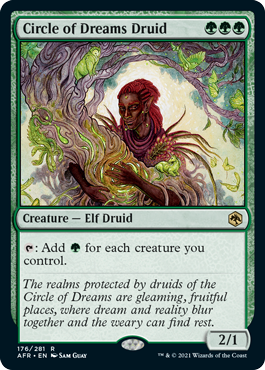
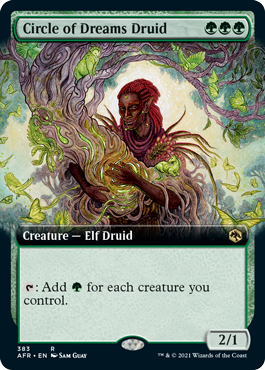
Dungeons
Dungeons are a major part of the D&D experience, and they're a big part of the Adventures in the Forgotten Realms experience as well. Dungeon is a brand-new card type. There are three dungeons in this set, including Dungeon of the Mad Mage. The three may be familiar to long-time D&D adventurers.
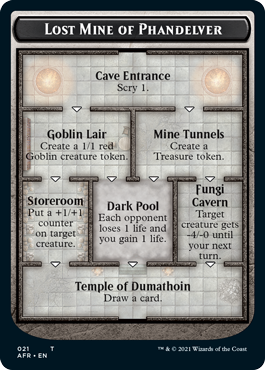


Dungeons don't go in your deck. Rather, they start outside the game and end up in the command zone for a while. More on that later. In games held under tournament conditions, "cards from outside the game" means cards from your sideboard, but dungeons work a little differently. Dungeons don't take up sideboard slots. You always have access to all three dungeons, and you'll never need more than one of the same one. If you're playing with dungeons, just keep them with your sideboard until you need them.
The way to bring dungeons into the game is a new keyword action: venture into the dungeon. Several traditional Magic cards (the ones that do go in your deck) will instruct you to venture into the dungeon. This could be the effect of a spell, an activated ability, or a triggered ability, as seen here on Shortcut Seeker.
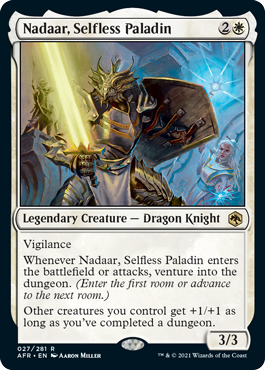
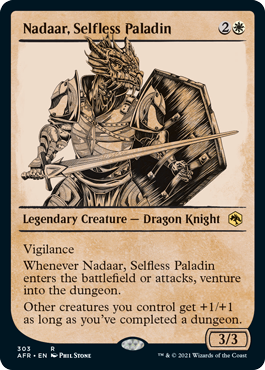
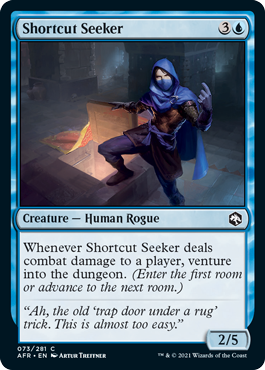
If you venture into the dungeon while you don't have any dungeons in the command zone, meaning you're not in a dungeon, it's time to start your journey! Put the dungeon of your choice into the command zone and put a venture marker on the first room, at the top. Your venture marker is a way for you to track which room you're in, just like a mini tells you where you are on a D&D map. Each player has their own dungeon all to themselves. There are no cards (as of this set; the future is long) that allow other players to interfere with your dungeon or your venture marker.
Every time you enter a room, including the first room, its room ability triggers. These abilities all read "When you enter this room, [the effect printed in the room]." For example, when you enter the Yawning Portal, you gain 1 life. Note that while all the rooms have individual names, those names are for flavor and don't affect gameplay.
Now that you're in a dungeon, the next time you venture into the dungeon, you'll move to the next room. You can't start a new dungeon until you complete the one you're in. When moving to the next room, follow the arrows down the card.
For example, from the Dungeon Level, you can choose to move to the Goblin Bazaar or the Twisted Caverns, but not both. You can never move backwards (up the card) in a dungeon. Backwards is a direction for cowards. You are no coward, and you'll block any warrior who says otherwise.
If you survive long enough, you'll reach the final room. After that room ability resolves or otherwise leaves the stack, the dungeon is removed from the game. Removing it from the game results in you completing the dungeon. (In some uncommon cases, you might venture into the dungeon in response to the final room ability. If that happens, you complete the dungeon you're in without waiting for the last room ability to leave the stack. You then start the next dungeon. That dungeon's first room ability will resolve before the previous dungeon's last room ability.)
Completing dungeons has two significant benefits. First, there are cards that care about this. Here's Gloom Stalker.
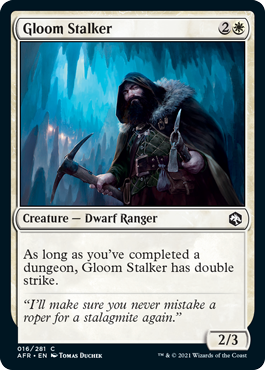
Note that Gloom Stalker doesn't have to be under your control as you complete the dungeon. It just shows up, takes one look at you, knows that you've completed a dungeon, and gives itself double strike. Game recognizes game.
Second, now that you're not in a dungeon, you're free to start a new one! The next time you venture into the dungeon, you can choose the very same dungeon you were just in or you can head into a new one. Want another dance with the Mad Mage? Think the Tomb of Annihilation is more to your liking? Want to concede and head to the tavern? You're writing the story here.
Dragons
There are plenty of Dragons in this set, but they're not really a mechanic. They just demanded equal billing after that dungeon section. So here it is. Yay, Dragons!
Ampersands
No. Stop.
Flavor Words
Each part of a Magic card can contribute to the story it tells. Names and creative text obviously pitch in, but rules text is often quite flavorful. But what if we did even more? Many abilities found in this set are preceded by flavor words—italicized terms that help tell the story of what's going on. In many cases, they identify a particular skill or feat a creature from the Forgotten Realms could have. A few modal cards in the set use flavor words to better illustrate your choices.
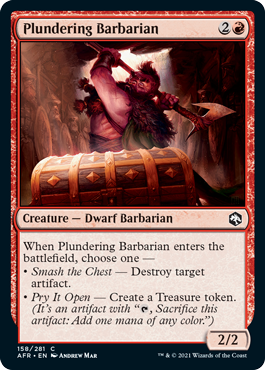
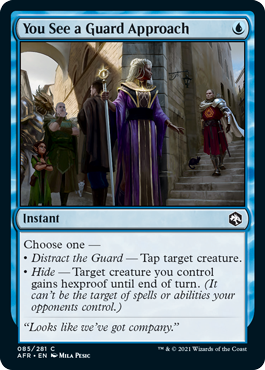
Flavor words look just like ability words, which is cool because neither has any rules meaning.
Roll a d20
Little is guaranteed while on an adventure. Sometimes you just have to see where fate takes you. No D&D-themed set would be complete without some d20s flying across the table. While some silver-clad adventurers are familiar with dice from previous unbelievable adventures, this marks the first time these particular elements of chance will be used in realms with borders cloaked in black. Let the good times roll.
Some effects in this set instruct you to roll a d20. A d20 is, of course, a 20-sided die. The other dice traditionally used in a game of D&D (d4, d6, d8, d10, d12, and percentile dice) don't show up in the main set. Some of them may show up elsewhere. It's hard to say; they're unpredictable.
Each card in the main set that asks you to roll a d20 will have a results table to show you what may happen. One nice thing is that, for the most part, you won't be penalized for a bad roll. Maybe the effect won't be as great, but the untimely fumble shouldn't sink you. For example, check out Lightfoot Rogue.
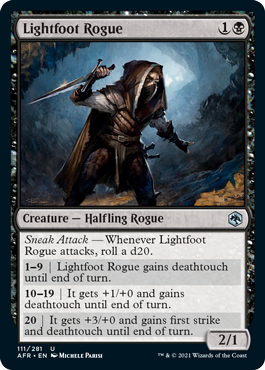
It'll pick up deathtouch for any result. Anything from 10 to 19 will also give it a small power bump, and a 20 will pack on the bonuses, making it a nightmare for your opponent to block.
Class
Are you the brave fighter who leads the charge? The studious cleric who keeps everyone alive? The charismatic bard who inevitably ends up on TikTok? New Class enchantments let you and your deck express your chosen vocation and demonstrate exactly what you bring to the party.
Twelve enchantments in the main set have the new subtype Class. Classes have their own set of rules to guide how they work. Let's take a look at Warlock Class.
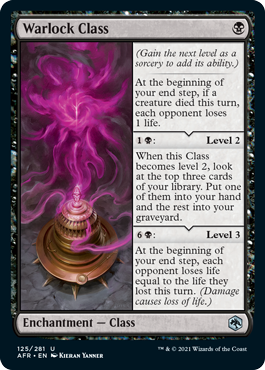
Each Class has three abilities in sections of its text box. We call those Class abilities. The Class also has two activated abilities that allow it to level up. The first Class ability is active as long as you control the Class. To get access to the other two Class abilities, you'll need to devote years to training and honing your craft. The path will be long, but your steadfast dedication will be rewarded.
Oh, wait, no, you just pay some mana.
As a sorcery, meaning during your main phase if the stack is empty, you can activate the level 2 ability. For Warlock Class, that will cost you {1}{B}. As that ability resolves, the Class will become level 2 and the first two class abilities will be active. For Warlock Class, the second Class ability is a one-time triggered ability that rewards your accomplishment with a card. But Class abilities can be anything—static abilities, activated abilities, or triggered abilities. Notably, a Class's level isn't tracked with or represented by counters. A Class's level is just something true about the permanent.
If a Class is level 2, the next stop is level 3. Again, as a sorcery, you can activate the level 3 ability. Pay {6}{B} to activate Warlock Class's level 3 ability. Once that ability resolves, all three Class abilities will be active. Note that you can activate a Class's level 3 ability only if the Class is level 2. No jumping right from level 1 to 3.
You can also multi-Class! You can control any number of Class enchantments, even multiples of the same one, at the same time. Each Class tracks its own level independently. So, if you control two Warlock Classes, advancing one to level 2 has no effect on the other one. But if you get more than one Warlock Class to level 3, their level 3 triggered abilities will each trigger at the beginning of your end step, and if the first one to resolve causes an opponent to lose life, that life loss will be counted by the next one to resolve. Fun! Um, for you. Less so for them. "Welcome to the D&D World"
Braving the Forgotten Realms is not an easy feat. It'll take a little luck, a lot of preparation, and initiative wouldn't be the worst thing. This article barely scratches the surface of what awaits. It's truly a Magic set like no other.

